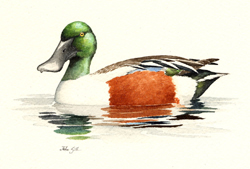Breeding Bird Atlases (BBA)
Find a Bird - BBA1
Breeding Bird Atlas 1 Species Accounts
Northern Shoveler
Anas clypeata
Egg Dates
Mid-May to early July
Number of Broods
one; may re-lay if first attempt fails.

This medium-sized dabbling duck, commonly called “spoonbill” by waterfowlers, is distinctive in profile due to its large, wide, specialized bill, which has comblike teeth used for sifting small crustaceans and other invertebrates from shallow waters and soft bottoms. However, like most other ducks, shovelers also consume large quantities of small seeds in fall and winter.
This species breeds throughout much of the Northern Hemisphere. In North America, it is primarily a breeding bird of western prairie sloughs and potholes. It has become increasingly common in the Northeast, where small numbers breed in fresh and brackish coastal ponds and shallow impoundments. In Massachusetts, a few pairs have nested in recent years at the Monomoy and Parker River national wildlife refuges. Shovelers are more common during migration, particularly in fall.
Like Blue-winged Teals, Northern Shovelers arrive on their breeding grounds, usually in pairs, after many other ducks have begun nesting. They are less vocal than most duck species. Females utter weak quacks, and males make low grunting notes, particularly during courtship and territorial defense. As with most dabbling ducks, the nest is in a shallow depression in a grassy area, usually close to the wetlands, where shoveler pairs loaf and broods are raised, but may be some distance from the water. One egg is laid each day until a clutch of ten to fifteen is complete. Incubation takes 24 to 25 days. If predators disrupt nests, hens will renest but will lay smaller clutches. Only a single brood is raised. The young soon develop the distinctive bill. They fly from 40 to 60 days after hatching. Females with small young have been recorded as late as mid-July at the Stage Island pool at Parker River National Wildlife Refuge (Gavutis). On Monomoy, a hen with seven young was observed on July 5 (Humphrey).
Drakes have no role in hatching eggs or raising young. They generally desert their mates soon after incubation starts, gather with other drakes of their own and other species on large wetlands with ample emergent cover, and molt into a female-like eclipse plumage that persists for about three months before it is replaced with the colorful nuptial plumage. All flight feathers are molted at one time, and the birds are secretive for the three or four weeks that they are flightless. Hens have their flightless period while they are rearing their broods.
Fall migrants appear as early as late August and reach peak numbers in early October. They can be found in suitable habitats inland as well as on the coast. Most have departed by mid-November for the wintering grounds, which extend from the southern United States south to northern South America. Winter records are rare in Massachusetts.
Map Legend and Data Summary
Atlas 1 data collected from 1975-1979


Note: rare and very local at Parker River and Monomoy national wildfile refuges
Ralph Andrews



